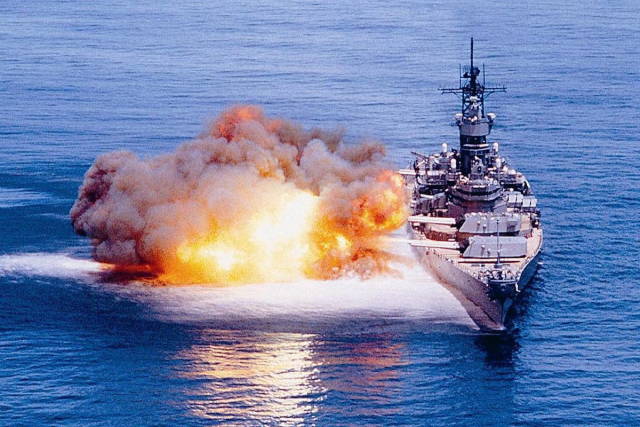Faced with operational access denial scenarios (anti-access/area denial, A2/AD) and advanced air defense systems, the Navies of leading Western states are working to improve their fire support facilities, focusing on higher-speed anti-ship weapons systems, long-range systems and unmanned platforms. At the same time, for navies with limited budgets and in cases of more liberal scenarios and crisis situations, there is still a need for more traditional solutions, namely guided munitions, missiles and barrage systems that allow solving a wide range of familiar tasks.
Fire support from Leonardo
According to representatives of the Leonardo company, today on the market the only qualified and affordable means of destruction of this kind for the Navy is the family of guided long-range (GLR) VULCANO 127-mm caliber, and soon 76-mm. The VULCANO 127 GLR was developed based on the joint requirements of the Italian Army and Navy for 155 mm and 127mm shells and qualified in 2019 in both calibers in accordance with the joint Italian-German memorandum of understanding. It complies with the NATO STANAG 4667 standard and is based on a common design for various calibers of a sub-caliber body with a tail.
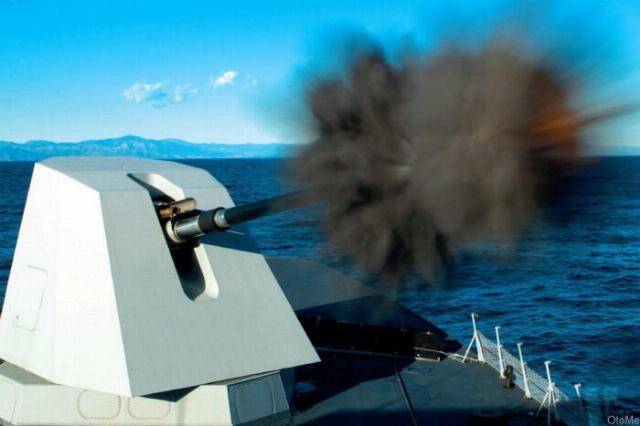
Leonardo 127/64 LW Naval Artillery installation
The product has precise control over a long range, which does not require a rocket engine or changes in the weapon system. The pre-prepared fragmentation component of the warhead (warhead) of the projectile is characterized by a high level of lethality. The mechanical interfaces are similar to standard ammunition and do not affect the rate of fire of the artillery system.
The final guidance is provided by an IMU/GPS unit, a programmable multifunctional fuse, as well as, optionally, interchangeable and self-guided infrared (IR) or semi-active laser (SAL) homing heads (GAN) from the German company Diehl Defense. The IR GOS is designed to hit moving surface targets at sea, and the laser GOS is designed for stationary or mobile targets with laser illumination carried out by a third party (for example, an advanced gunner).
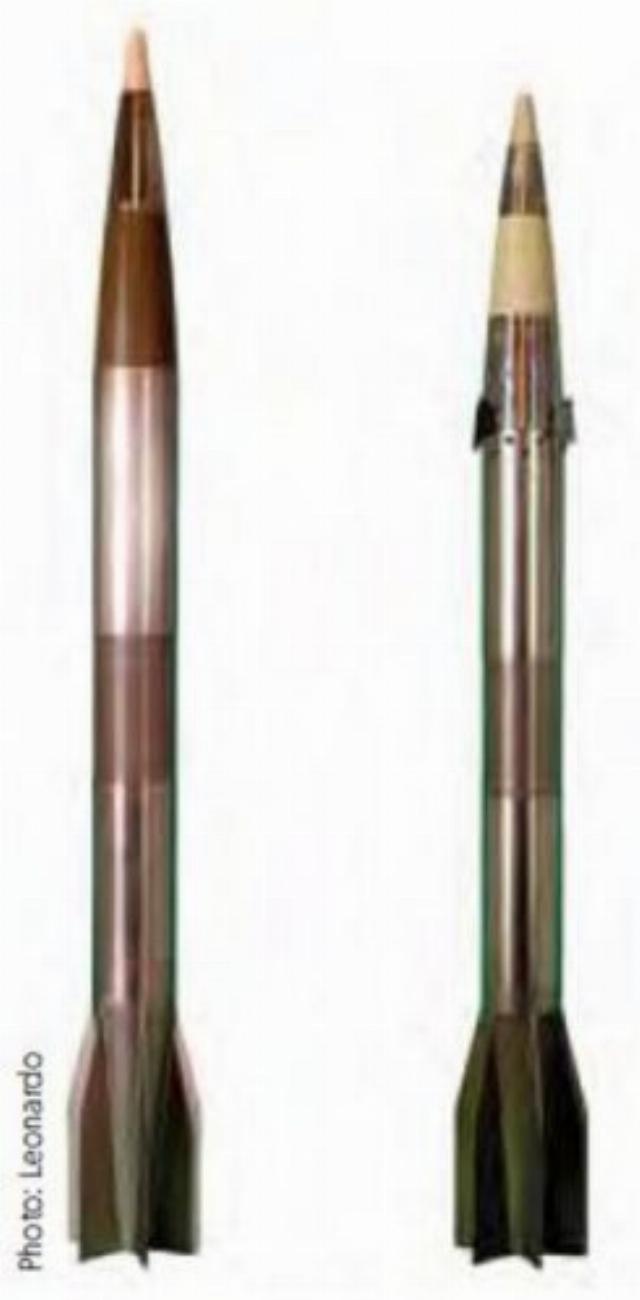
VULCANO 127 BER (left) and GLR (right) projectiles
The Italian Navy conducted an operational inspection of ammunition in 2017-2018 during live firing at sea from Leonardo 127/54C and 127/64 LW (light weight) guns. As a result, both guns are the only ones qualified for the use of GLR ammunition through the combat control systems (SBU) of ships with fully automated ammunition handling. The Italian Navy has also qualified VULCANO BER (Ballistic Extended Range) ammunition, without a guidance kit, capable of reaching a range of 60 km when fired from a Leonardo 127/64 LW cannon and potentially from a BAE Systems Mk45 cannon, since integration with US Navy systems has not yet been carried out.
In a specific 155-mm version, the VULCANO ammunition has also passed successful ground tests with the AGS (Advanced Gun System) artillery system from BAE Systems installed on ZUMWALT-class destroyers The U.S. Navy. It is claimed that when firing from the 127/64 LW cannon, the VULCANO 127 GLR projectile can reach a range of up to 90 km, providing a targeted attack in any weather (CVO less than 5 m). According to the latest multi-year defense planning document (2021-2023), the Italian Ministry of Defense (MOD) has an ongoing program for the procurement and support of serial production of VULCANO 127 GLR with financing starting in 2021.
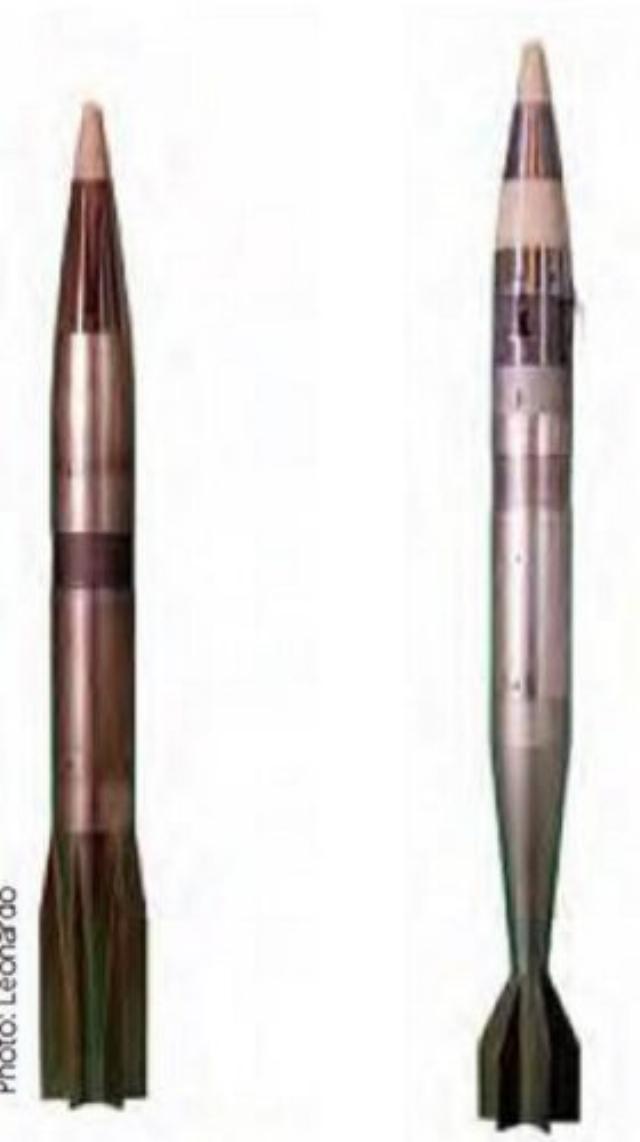
VULCANO 76 BER (left) and GLR (right) projectiles
Meanwhile, in Italy, as part of the SINGLE DECK program for the development and qualification of the 76/62 artillery installation, the VULCANO GLR ammunition for the 76/62mm SUPER RAPIDO (SR) artillery system is being tested. It is planned that the VULCANO 76 GLR with a firing range of up to 40 km will be available for production in the period 2023-2024. This will further enhance the fire support capabilities of the SR gun on the international market, since the VULCANO 76 BER ammunition has already been qualified and is in service with at least one customer from South Asia.
In addition to the Italian and German Navies, 127/64 LW VULCANO artillery units were also acquired by Algeria, the Netherlands, Spain and Canada, which made them potential candidates for the purchase of VULCANO 127 GLR shells. Egypt, which has already received two FREMM-type frigates equipped with 127/64 LW VULCANO, and according to Italian export documentation is the first international customer of the VULCANO 127 BER ammunition, potentially may also soon acquire VULCANO 127 GLR. Various 76/62 SR operators have shown great interest in the VULCANO 76 GLR, as both 76/127 mm Leonardo guns are supplied adapted for GLR ammunition.
Solutions for the US Navy
As expected, the development and emergence in recent years of new long-range threats presented by hypersonic systems and the need to develop new defensive and offensive capabilities have pushed the US Navy to recapitalize resources into longer-range and high-speed weapons systems. In 2016, the Fleet command abandoned the 155-mm long-range projectile designed to hit ground targets (Long Range Land Attack Projectile, LRLAP) and for the AGS artillery system from BAE Systems installed on the destroyers of the Zamvolt project. The construction of the latter in the same year 2016 was reduced to three ships, which made it impossible to benefit from the scaling effect.
Efforts to find an alternative to LRLAP were halted as the US Navy revised the tasks of the Zamwalt platforms and shifted them from supporting coastal operations of ground forces to defeating enemy surface ships on the high seas. In April 2021, the Chief of Naval Operations of the U.S. Navy announced that the Zamvolt destroyers would be the first naval platforms equipped with hypersonic missiles. Meanwhile, the industry has developed technologies and solutions that meet the requirements of the US Navy for fire support of ships equipped with 5-inch (127 mm) guns.

127 mm guided projectile EXCALIBUR N5
Thus, Raytheon, together with BAE Systems BOFORS, offered the 155-mm guided artillery shell EXCALIBUR, which is already in production and is in service with the US Army and allies. For fire support from the sea, a special version of its "En 5" (EXCALIBUR N5) has been developed, adapted for 127-mm Naval guns. According to the manufacturer, the N5 doubles the firing range of naval artillery systems, providing the same accuracy as the ground version (read more here and here ). The developers conducted a series of ground firings to demonstrate to the Navy the capabilities of the N5, which reuses the guidance and fuse components from the EXCALIBUR Block 1B.
It is known that Lockheed Martin and Orbital ATK (today Northrop Grumman Innovation Systems) offered their solutions. The latter focused on the PGK Precision Guidance Kit. In turn, BAE Systems, relying on a partnership with Leonardo, offered VULCANO GLR ammunition. The subsequent rejection of these proposals means that the only potential solution for the US Navy remains the so-called "hyperspeed projectile" type HVP (Hyper Velocity Projectile), better known as the GLGP (Gun-Launched Guided Projectile) artillery projectile, developed by BAE Systems for the US Armed Forces and their allies.
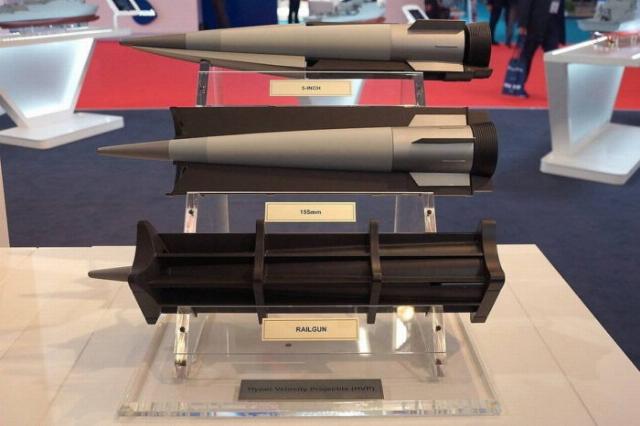
HVP shells for 127 mm, 155 mm guns and railgun
The product is described as a conventional guided projectile of a new generation with low drag. It is claimed to be suitable for attacking ground targets, hitting cruise and ballistic missiles, fighting surface ships, as well as for performing other tasks solved with the help of artillery systems. Among the latter, first of all, the 5-inch (127-mm) and 155-mm systems of the Navy, Marine Corps and Ground Forces, as well as promising electromagnetic railguns (EMRG) are considered. When firing from 127 mm and 155 mm guns, the HVP is capable of reaching a speed of MACH 3. According to BAE Systems, the target range is more than 93, 130 and 80 km, depending on the Mk 45 Mod 4, AGS or 155 mm artillery systems, respectively.
As part of a series of tests conducted by the Navy in conjunction with the Headquarters and (Office of Secretary of Defense, OSD) and the Office of Strategic Capabilities (Strategic Capabilities Office, SCO) In the summer of 2018, the USS DEWEY of the ARLEIGH BURKE type launched 20 HVP shells as an inexpensive means of combating missile weapons and UAVs. At the White Sands missile range, in late summer 2020, HVP fire was conducted from a 155 mm AGS cannon mounted on an M110 self-propelled artillery chassis. Fire control was carried out through the advanced Onramp 2 DBMS and ensured the successful defeat of cruise missile simulators.
However, in its proposed budget for fiscal year 2022, the U.S. Department of the Navy discontinued GLGP research and development. Potential reinvestments in the program are scheduled to be reassessed after the ongoing efforts of the Office of Strategic Capabilities "to analyze terminal protection" are completed. Meanwhile, in March 2020, OSD/SCO, with the support of the US Army, signed a $16 million contract with BAE Systems. The United States to finalize and demonstrate the lethality of HVP against ground targets at extremely long ranges. During 2021 and 2022, the company is tasked with improving existing HVP capabilities and testing the enhanced potential of the "hyperspeed projectile".
To be continued…
Based on the materials of the European Security & Defense magazine
